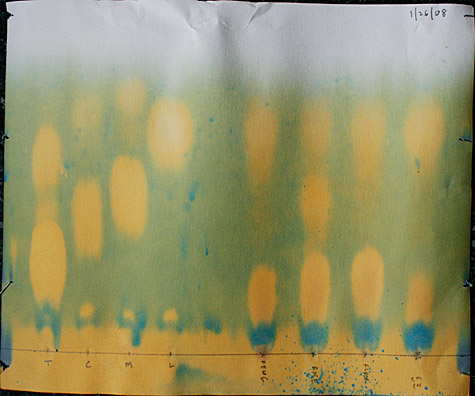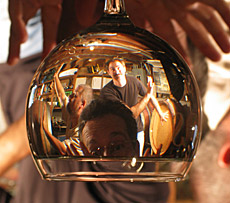Thanks, judges!
 Tom Wark, impressario of the influential wine blog Fermentation, just sent word that we’ve made it into the finals of the American Wine Blog Awards this year — in the “Best Overall Wine Blog” category, no less. Wow! And we don’t even own overalls!
Tom Wark, impressario of the influential wine blog Fermentation, just sent word that we’ve made it into the finals of the American Wine Blog Awards this year — in the “Best Overall Wine Blog” category, no less. Wow! And we don’t even own overalls!
Seriously though, that’s news as amazing as it is humbling. Many thanks to the judges for wading through our stuff (really, it comes off with pumice stone and a little proxy-carb) and selecting us as one of four finalists in our category. These anonymous and dedicated folks — hopefully inebriated to dull the pain — surely had their work cut out for them, slogging through scores of blogs to winnow a list from which you now get to choose.
Of course, running that gauntlet now appears to have been the easy part. We’re up against some stiff competition in our category, two of them long-time denizens of our blogroll at right. I had the honor of hosting Vinography‘s Alder Yarrow at last year’s IPNC, and I can assure you he’s as knowledgeable, passionate, and still somehow good-humored about wine as he comes off in his blog. And up against Eric Asimov’s seminal New York Times blog, The Pour? Man, we’ll be lucky if I vote for us.
But, er, don’t let me talk you out of it. Check out list of finalists across all the categories and vote for the ones that most drive you to drink – wine, anyway. Voting is open until 12:01am on March 29th.
4 commentsScience meets art

[poll=3]
Gosh, what’s the correct answer? Find out after the fold!
Read more
Let’s do some more numbers
Just got back the juice panel analysis of the cabernet sauvignon we picked last Saturday:
brix 24.1 degrees glucose + fructose 25.5 g/100mL pH 3.57 titratable acidity 0.54 g/100mL tartaric acid 3.71 g/L L-malic acid 3.06 g/L potassium 1760 mg/L alpha-amino compounds 76 mg/L ammonia 65 mg/L yeast assimilable nitrogen 130 mg/L (as N)
Considering other Eastern Washington fruit we’ve picked over the years, that acidity is about as perfect as you can get, and that pH is positively robust. Good structure, good health. The only minor worry is the last number, but we can easily add nutrients to the must to compensate.
All in all, pretty perfect numbers! Now all we have to do is not screw it up!
No commentsSon of Road Trip: the Cabernet
 Just a little after 6am, Whit and I unlocked the Flexcar truck, stowed tarps and tie-downs in the back, and headed east through foggy, deserted streets. The chill was penetrating, but in that autumnal way that betrays a certain lack of conviction: soon enough, it would dissolve into a warm, Indian summer day.
Just a little after 6am, Whit and I unlocked the Flexcar truck, stowed tarps and tie-downs in the back, and headed east through foggy, deserted streets. The chill was penetrating, but in that autumnal way that betrays a certain lack of conviction: soon enough, it would dissolve into a warm, Indian summer day.
A few miles past Hood River, the sun began to slice through the mist and dispel it back up into the hills, lifting a cascade of blue-monochrome buttes into view down the Gorge. By the time we crossed the Columbia and pointed north, the sun had cleared the way for a perfect grape run into the Yakima valley.
 The grower had already picked a few thousand pounds for us and another guy who arrived just moments later. My spot test with the refractometer, trying to pick a random assortment of berries, pegged the sugar somewhere between 23 and 27 – pretty ripe at the upper register, maybe just shy of ripe at the bottom. Any harvest short of Château d’Yquem‘s berry-by-berry picking regimen will have this kind of variation: you just hope the spread is relatively tight and the average is where you want to be. So if this really netted us 25 brix, we wouldn’t complain.
The grower had already picked a few thousand pounds for us and another guy who arrived just moments later. My spot test with the refractometer, trying to pick a random assortment of berries, pegged the sugar somewhere between 23 and 27 – pretty ripe at the upper register, maybe just shy of ripe at the bottom. Any harvest short of Château d’Yquem‘s berry-by-berry picking regimen will have this kind of variation: you just hope the spread is relatively tight and the average is where you want to be. So if this really netted us 25 brix, we wouldn’t complain.
Read more
Fermentation has begun!
Whit and I checked the Merlot late last night and it looks like we have ignition! The cap was just tentatively beginning to rise, and when Whit punched it down, the yeasts bubbled happily through the grape goo.
Then, this morning, I checked the Franc to discover that it has also decided to follow in its brother’s footsteps, so we’re firing on both cylinders. That means a steady regimen of punching down the cap, keeping track of sugar levels and temperature, and coming home every day to a house filled with beautiful fragrance.
Life is good!
No commentsLet’s do the numbers
 Got the numbers back from ETS, and as we guessed from the taste of the grapes, the Merlot should have been picked earlier. The upshot is that we’ll need to strap the Merlot to the treadmill and tone it up a bit, adding some acid to drop its pH into healthier territory and sharpen its fruit, and perhaps add some water to pull the potential alcohol down into balance.
Got the numbers back from ETS, and as we guessed from the taste of the grapes, the Merlot should have been picked earlier. The upshot is that we’ll need to strap the Merlot to the treadmill and tone it up a bit, adding some acid to drop its pH into healthier territory and sharpen its fruit, and perhaps add some water to pull the potential alcohol down into balance.
The Franc looks a lot better, but like the Merlot, will need to be monitored through the ferment because of their low yeast assimilable nitrogen content (or more colorfully, YANC). That potentially soporific term essentially characterizes how much nitrogen the yeast have to feed on to keep themselves fit and healthy through the ferment. From a paper by the Food Science and Technology department at OSU:
If the levels of fermentable nitrogen are too low, the total cell biomass produced will be low, the yeast fermentation may be slow, and the fermentation may stop or `stick’ before all the fermentable sugar is utilized. Yeast under nutritional stress due to nitrogen deficiency may also produce hydrogen sulfide (rotten egg) and other sulfur compounds with offodors
So we’ll definitely be adding some yeast nutrient and tasty-sounding di-ammonium phosphate (DAP) to both of these ferments to keep the yeasts happy and healthy.
The complete numbers and some more comments after the jump…
Road trip for Franc and Merlot
 At about 7am Saturday morning, Hal and I set out with Laura’s truck and trailer to find America – and barring that, ripe Cabernet Franc and Merlot. We’d packed plenty of tie-downs and enough plastic sheeting to Cristo a garage, having learned in previous years that you can’t have too much grape-wrap.
At about 7am Saturday morning, Hal and I set out with Laura’s truck and trailer to find America – and barring that, ripe Cabernet Franc and Merlot. We’d packed plenty of tie-downs and enough plastic sheeting to Cristo a garage, having learned in previous years that you can’t have too much grape-wrap.
The morning was drizzly in Portland, but as we passed the Dalles, the weather lightened and the low autumnal sun began to slice across the hills, giving them the soft suppleness of suede. As we crossed the Columbia at Biggs and scaled the bluffs overlooking the water, the view downriver was both calm and majestic. It’s a 3-1/2 hour drive each way to the vineyard, but that glance over your shoulder in the early morning light always makes it easier.
 Just out of Sunnyside, we pulled into the vineyard, where, as advertised, it was indeed sunny. The grower had already stacked the Franc in small white picking bins, ready for weighing. We’d always rather taste and test the grapes before they’re picked, but this grower just does what he does and you hope for the best.
Just out of Sunnyside, we pulled into the vineyard, where, as advertised, it was indeed sunny. The grower had already stacked the Franc in small white picking bins, ready for weighing. We’d always rather taste and test the grapes before they’re picked, but this grower just does what he does and you hope for the best.
